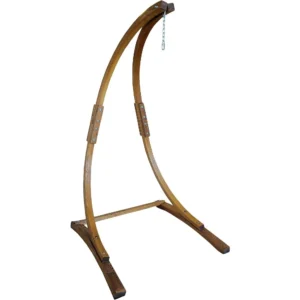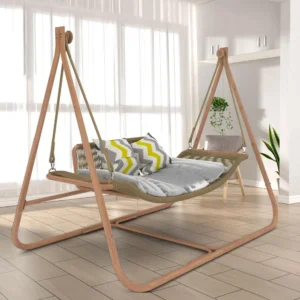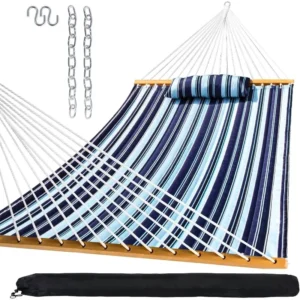Introduction to Swings and Hammocks
When it comes to outdoor relaxation, few options provide the same level of comfort and enjoyment as swings and hammocks. These suspended leisure items have been bringing joy and relaxation to people for centuries, though in distinctly different ways.
A swing is a seat suspended by ropes or chains from an overhead support, designed primarily for seated enjoyment and a rhythmic back-and-forth motion. Meanwhile, a hammock is a suspended bed made of fabric, rope, or netting, typically hung between two points and designed for reclining or lying down.
As outdoor living spaces become increasingly important in home design, understanding the differences between these relaxation options has never been more relevant. The outdoor living market has seen consistent growth, with more homeowners investing in quality outdoor furnishings that extend their living space beyond the walls of their home.
Both swings and hammocks share the fundamental characteristic of being suspended, but they differ significantly in form, function, and the experience they provide. Whether you’re looking to create a playful outdoor environment, a peaceful retreat, or something in between, knowing these differences is crucial to selecting the perfect option for your space and needs.
In this article, we’ll explore what makes swings and hammocks unique, compare their key features, and help you determine which might be the better choice for your specific situation. For those interested in exploring various options, our ultimate guide to porch swing hammocks offers comprehensive information on these versatile relaxation solutions.
Defining Features: What Makes a Swing a Swing
A swing, at its core, is defined by its suspended seat and pendular motion. This simple yet effective design has remained largely unchanged throughout history, though materials and styles have evolved significantly.
Core Characteristics of Swings
- Suspended Seat: A platform or seat hung from above
- Pendular Motion: Back-and-forth movement in an arc
- Vertical Support Structure: Requires robust overhead support
- Seated Position: Primarily designed for sitting upright
- Active Engagement: Often involves user-generated movement
Swings are designed primarily for seated enjoyment and can range from simple playground varieties to elaborate porch swings with cushioned seating and decorative elements. The benefits of swinging motion extend beyond simple enjoyment – the rhythmic movement can be calming, stimulate balance development in children, and provide gentle exercise.
Common materials used in swing construction include:
- Wood: Traditional, durable, and aesthetically pleasing
- Metal: Strong, weather-resistant, and low-maintenance
- Plastic: Lightweight, affordable, and easy to clean
- Rope: Used primarily for suspension but sometimes for the seat itself
Swings come in numerous varieties, including playground swings, porch swings, tree swings, and swing sets. Each type serves slightly different purposes and fits different environments, but all maintain the core characteristic of seated, pendular motion.
For those looking to add this classic form of outdoor enjoyment to their space, Outside Luxe offers various porch swing chair sets that combine comfort with durability.
Defining Features: What Makes a Hammock a Hammock
A hammock, unlike a swing, is fundamentally designed as a suspended bed or lounging surface rather than a seat. This distinction drives many of the key differences between these two suspended leisure items.
Core Characteristics of Hammocks
- Suspended Fabric/Rope Bed: A flexible surface that cradles the body
- End-to-End Suspension: Typically hung between two anchor points
- Reclining Position: Designed for lying down rather than sitting
- Body-Conforming Support: Molds to the user’s body shape
- Gentle Sway: Subtle multi-directional movement rather than pendular motion
Hammocks have a rich cultural history, with variations developed by different civilizations around the world. The design continues to evolve, with modern innovations focused on comfort, durability, and ease of setup.
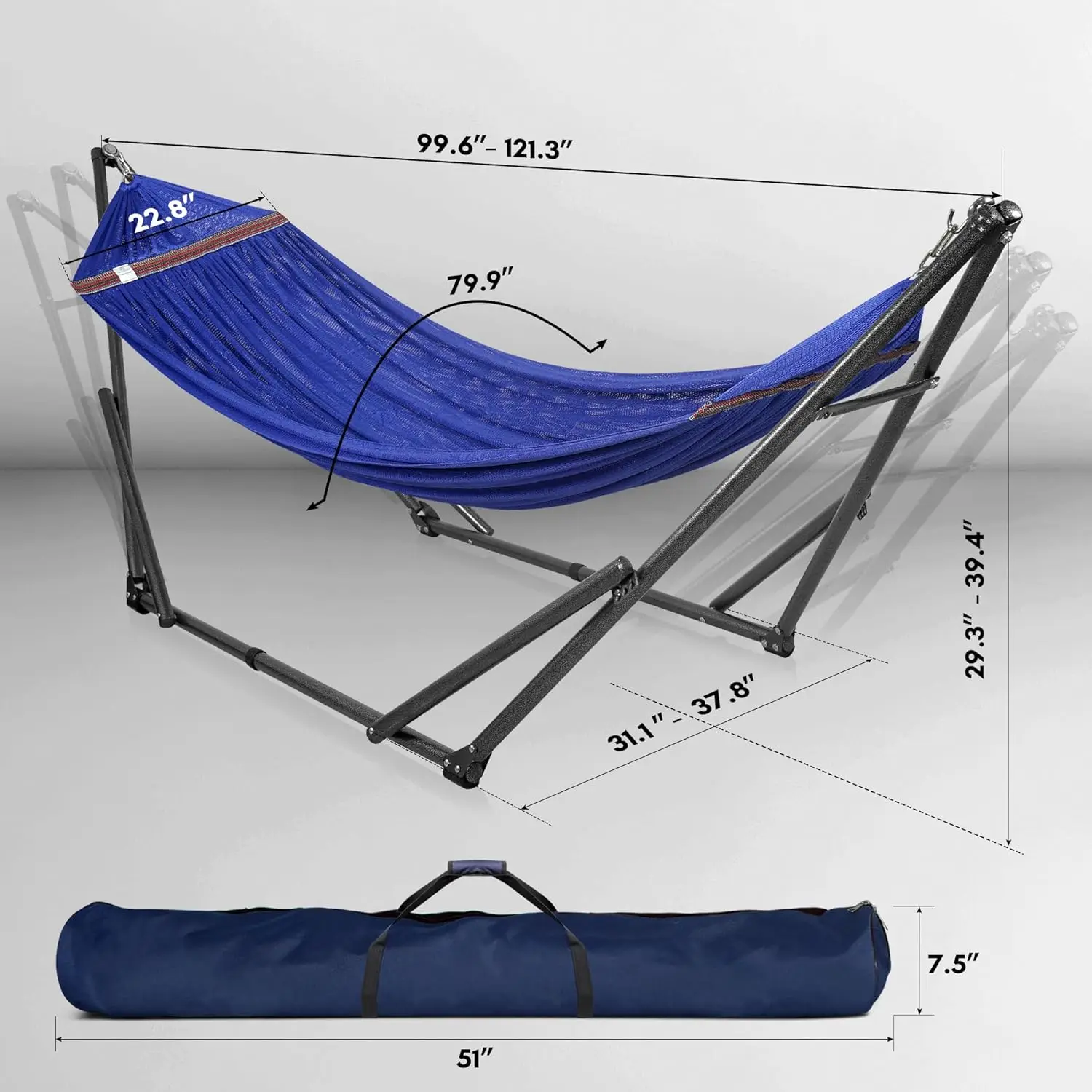
Common hammock styles include:
- Brazilian: Features a tightly woven cotton fabric for a bed-like surface
- Mayan/Nicaraguan: Made with an open weave of thin cords, providing ventilation
- Spreader Bar: Uses wooden bars to keep the hammock open and flat
- Camping/Portable: Lightweight, packable designs for travelers and backpackers
- Quilted: Padded for extra comfort with fabric on both sides
Materials used in hammock construction vary widely, each offering different benefits:
- Cotton: Soft, comfortable, absorbent but requires more maintenance
- Polyester: Weather-resistant, durable, quick-drying
- Nylon: Extremely lightweight, strong, ideal for portable hammocks
- Rope: Traditional appearance, good ventilation, textured surface
The most comfortable hammock type depends largely on your intended use, but all share the defining feature of providing a suspended, body-cradling surface for relaxation. For a wide selection of options, explore our hammocks with stands collection to find the perfect match for your space.
Side-by-Side Comparison: Key Differences Between Swings and Hammocks
Understanding the fundamental differences between swings and hammocks can help you make an informed decision about which option best suits your needs. Here’s a comprehensive comparison of these popular outdoor relaxation solutions:
| Feature | Swing | Hammock |
|---|---|---|
| Primary Use | Active enjoyment, play, gentle rocking | Relaxation, lounging, sleeping |
| Body Position | Seated, upright | Reclined or lying down |
| Movement | Pendular (back-and-forth arc) | Gentle multi-directional sway |
| Support Structure | Overhead beam or frame | Two separate anchor points |
| Experience | Rhythmic, active | Cradling, enveloping |
| Common Materials | Wood, metal, plastic, rope | Cotton, polyester, nylon, rope |
| Space Requirements | Vertical clearance plus swing arc | Linear distance between anchor points |
| Installation Complexity | Moderate to high (structural support) | Low to moderate (secure anchor points) |
| Portability | Generally stationary | Often portable, especially camping styles |
| Weight Capacity | Varies (typically 250-600 lbs) | Varies (typically 250-800 lbs) |
One of the most significant differences is how each interacts with your body. Swings keep users in a more defined, seated position and encourage active movement, making them ideal for social settings and active enjoyment. Hammocks, on the other hand, cradle users in a reclined position, conforming to body contours and promoting deeper relaxation.
Installation requirements also differ substantially. Swings require robust overhead support that can withstand dynamic loading (the forces generated by swinging motion). Hammocks distribute weight between two anchor points and generally create less dynamic force, though they require sufficient distance between anchor points.
For those interested in understanding how these differences compare to other seating options, our guide on patio chairs versus swing hammocks offers additional comparative information to help with your decision.
The Motion Experience: Physics of Movement
The motion experience is perhaps one of the most distinguishing factors between swings and hammocks, creating fundamentally different sensations for users.
Swing Motion: Pendular Arc
Swings operate on pendulum physics, creating a predictable back-and-forth arc motion. This movement:
– Has a consistent rhythm determined by the length of the suspension
– Requires initial energy input (pushing off) but can maintain momentum
– Creates a defined path of motion in a single plane
– Produces a dynamic sensation with changing forces
– Can be actively controlled by the user
The rhythmic nature of swinging has been shown to have calming effects on the brain, similar to rocking. This is one reason why relaxing porch swing hammocks have become popular features in outdoor relaxation spaces.
Hammock Motion: Multi-Directional Sway
Hammocks, by contrast, offer a gentler, more subtle motion experience:
– Creates a gentle, multi-directional sway rather than a defined arc
– Responds to subtle shifts in body weight
– Produces more of a floating sensation
– Motion naturally dampens rather than builds momentum
– Creates a cradling effect that many find deeply relaxing
The hammock’s subtle movement works in harmony with its body-cradling design to create a uniquely relaxing experience. This combination explains why hammocks have traditionally been associated with deep relaxation and even sleep.
These different motion experiences make swings and hammocks suitable for different purposes—swings for more active enjoyment and hammocks for deeper relaxation.
Comfort and Body Positioning
The way swings and hammocks support your body creates fundamentally different comfort experiences, each with its own benefits and considerations.
Swing Body Position
Swings maintain users in a primarily seated position with:
– Defined seating surface supporting the lower body
– Back support in many designs (especially porch swings)
– Feet typically touching the ground or dangling
– More upright posture encouraging engagement with surroundings
– Limited ability to fully recline
This positioning makes swings ideal for active use, conversation, and maintaining awareness of your surroundings.
Hammock Body Position
Hammocks cradle the body in a reclined position with:
– Even weight distribution across the entire body
– Natural curve that supports the spine when hung properly
– No pressure points when properly positioned
– Full body support from head to toe
– Cocoon-like embrace in traditional designs
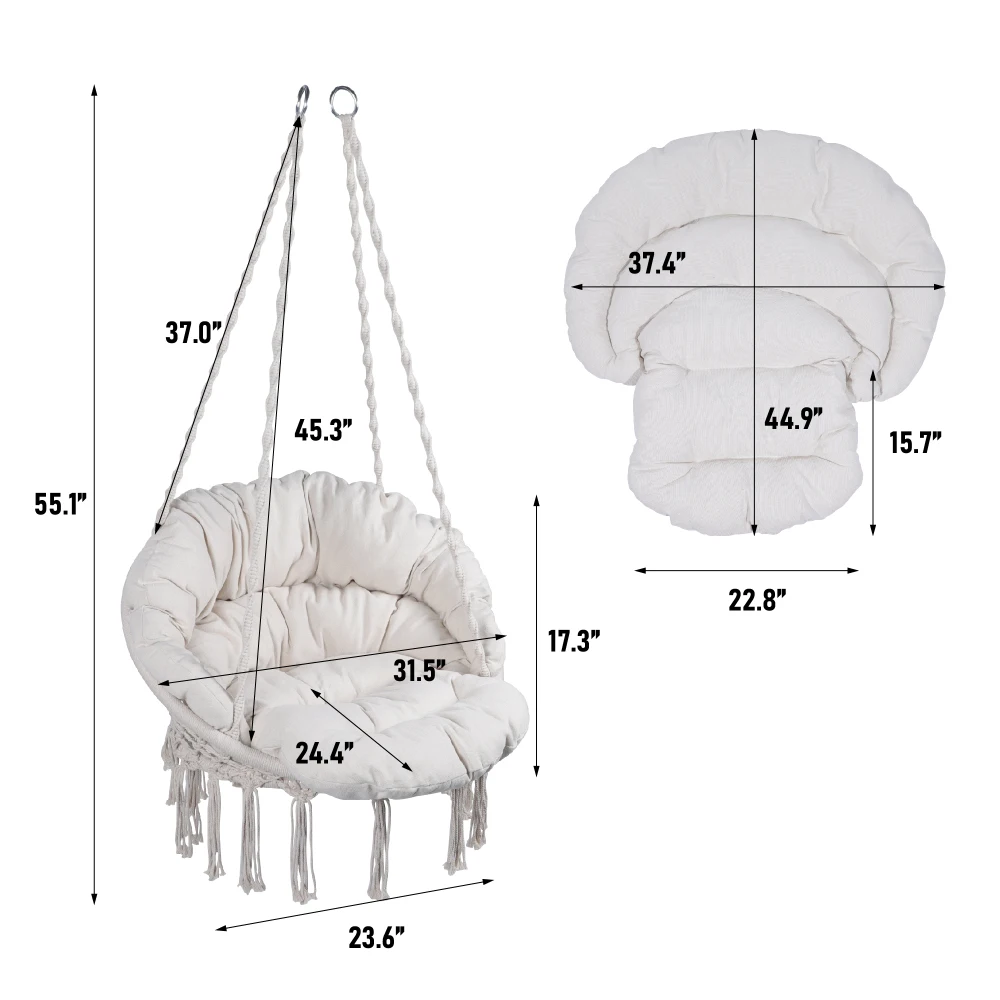
This body-conforming support explains why many people find hammocks exceptionally comfortable for extended relaxation. The ideal hammock angle (approximately 30° from horizontal) creates a position that many find perfect for reading, napping, or simply unwinding.
For those seeking a middle ground between these positions, hammock chairs with stands offer an interesting hybrid that provides more support than traditional hammocks while allowing for a more reclined position than typical swings.
Installation Requirements and Placement Options
The installation needs for swings and hammocks differ significantly, affecting where and how they can be used in your space.
Swing Installation Requirements
- Robust Overhead Support: Must support dynamic loads (3-4× the static weight)
- Vertical Clearance: Typically needs 7-8 feet (2.1-2.4 m) overhead
- Swing Clearance: Requires 3-4 feet (0.9-1.2 m) clearance on all sides
- Level Surface Below: For safety during use
- Secure Mounting Hardware: Rated for outdoor use and weight capacity
Swings generally require more structural consideration for safe installation. Proper installation techniques for porch swing hammocks are essential for ensuring safety and longevity.
Hammock Installation Requirements
- Two Sturdy Anchor Points: Trees, posts, or walls 12-15 feet (3.7-4.6 m) apart
- Proper Hanging Height: Typically 18 inches (45 cm) from the ground when weighted
- Hanging Angle: Ideally creating a 30° angle from horizontal when weighted
- Sufficient Clear Space: No obstacles within the hanging area
- Appropriate Hardware: Straps, hooks, or rings rated for the weight
Hammocks offer more flexibility in terms of location, especially when used with a stand. Finding the best place to put a hammock involves considering factors like shade, view, and privacy alongside the technical requirements.
Both options also come in free-standing versions that eliminate the need for permanent installation, making them suitable for renters or those who prefer flexibility in placement.
Hybrid Options: When Swings Meet Hammocks
The line between swings and hammocks isn’t always clear-cut. Several popular products combine elements of both to create unique relaxation experiences.
Common Hybrid Designs
Hammock Chairs: These hanging seats combine the seated position of a swing with the fabric suspension system of a hammock. They typically hang from a single point and allow for gentle rotation as well as swinging motion.
Egg Chairs: These enclosed, egg-shaped seats hang from a stand and create a cocooning effect similar to hammocks while maintaining a more defined seating position.
Swing Beds: Larger than typical porch swings, these suspended beds offer the pendular motion of swings with the lying capacity of hammocks.
These hybrid options are ideal for those who:
– Want both swinging motion and body-cradling comfort
– Have limited space for full-sized hammocks
– Prefer a more upright position than traditional hammocks
– Seek the enveloping comfort of hammocks with easier entry/exit
Our swinging hammock chair sets offer a perfect middle ground, combining the best features of both worlds for versatile outdoor relaxation.
Choosing the Right Option: Decision Guide
Selecting between a swing, hammock, or hybrid option comes down to understanding your specific needs and preferences.
Consider Your Primary Purpose
For Active Enjoyment or Children: Swings provide dynamic motion and structured seating that’s ideal for active use and safer for children.
For Deep Relaxation or Napping: Hammocks offer unparalleled full-body support and gentle sway that promotes deep relaxation.
For Social Seating: Larger porch swings or swing beds accommodate multiple people while maintaining conversation-friendly positioning.
For Portable Options: Camping hammocks win for portability, packing down small enough for backpacks.
For Limited Space: Hammock chairs or compact swings can fit in smaller areas while still providing relaxation benefits.
Assess Your Available Space
Your available space may naturally guide your decision:
- Have sturdy overhead support? A swing or hammock chair might be ideal.
- Have widely spaced trees or posts? Traditional hammocks could be perfect.
- Limited fixed anchor points? Consider stand-based options for either style.
- Small patio or balcony? Hammock chairs or compact swings conserve space.
Consider User Comfort Preferences
Different body types and comfort preferences may favor one option:
- Prefer defined seating support? Choose swings or hammock chairs.
- Enjoy full-body relaxation? Traditional hammocks offer the most “floating” sensation.
- Have mobility concerns? Swings with proper back support may be easier to use.
Our guide on patio-friendly swinging hammock chairs offers additional guidance for selecting options that work well in various spaces.
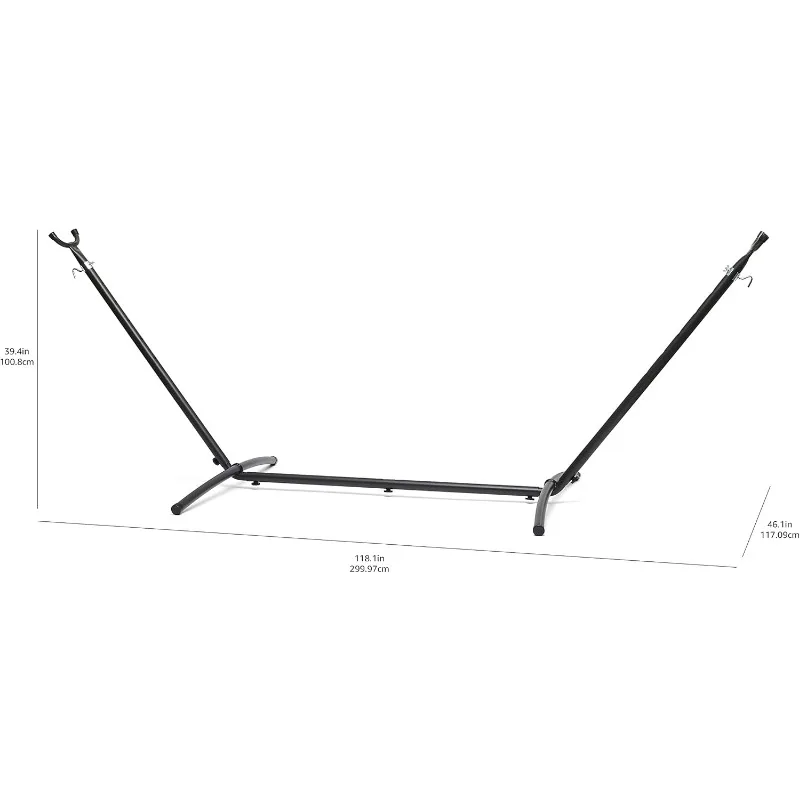
Dark Wood Hammock Sets, Porch Swing Chair Sets
$653.82 Select options This product has multiple variants. The options may be chosen on the product pageA-Frame Stand Hammock Sets, Swinging Hammock Chair Sets
$154.62 Select options This product has multiple variants. The options may be chosen on the product pageLight Wood Hammock Sets, Swinging Hammock Chair Sets
$1,359.35 Select options This product has multiple variants. The options may be chosen on the product pageClassic Wooden Stand Hammock Sets, Heavy Duty Hammock Sets
$1,061.68 Select options This product has multiple variants. The options may be chosen on the product pageHammock Sets with Canopy, Heavy Duty Hammock Sets
$286.31 Select options This product has multiple variants. The options may be chosen on the product page
Safety Considerations for Both Options
Whether you choose a swing or hammock, safety should always be a primary consideration during selection, installation, and use.
Swing Safety Checklist
- Installation Security: Ensure overhead support can handle dynamic weight (3-4× static weight rating)
- Hardware Inspection: Regularly check chains, hooks, and fasteners for wear
- Clearance Zone: Maintain 3-4 feet (0.9-1.2 m) clear space around all sides
- Weight Limits: Adhere to manufacturer’s specified weight capacity
- Surface Below: Consider impact-absorbing material underneath
- Child Safety: Provide appropriate supervision and age-appropriate designs
Hammock Safety Checklist
- Anchor Strength: Verify anchor points can support at least 3× the intended weight
- Proper Height: Hang 18 inches (45 cm) from ground when weighted
- Hanging Angle: Maintain proper 30° angle for stability
- Weight Distribution: Center weight in the hammock
- Regular Inspection: Check fabric, ropes, and connections for wear
- Entry/Exit Technique: Use proper technique to prevent tipping
For users concerned about durability and support, our heavy-duty hammock sets are engineered with safety and stability in mind, providing peace of mind for extended relaxation.
Can You Have Both? Integration in Your Space
Who says you have to choose? Many outdoor enthusiasts successfully incorporate both swings and hammocks into their outdoor living spaces, creating versatile relaxation zones that serve different purposes.
Complementary Placement Strategies
- Zone your yard: Dedicate different areas to different relaxation styles
- Consider seasonal rotation: Use hammocks in warmer months and swings in cooler seasons
- Evaluate multi-use structures: Some pergolas or frames can support both options
- Utilize different views: Position each to take advantage of different landscape views
- Create activity-specific areas: Swings near play areas, hammocks in quieter zones
With thoughtful placement, even modest-sized yards can accommodate multiple relaxation options. Our guide on perfect porch swing hammock locations provides inspiration for integrating various options in the same area.
The key is to consider how each piece will be used and position them to complement rather than compete with each other in your outdoor living space.
Is a Swing or Hammock Better for You? Final Thoughts
After exploring the key differences between swings and hammocks, it’s clear that neither option is universally “better”—each excels in different areas and serves different purposes.
Swings offer active enjoyment with their pendular motion and upright seating position, making them ideal for social settings, gentle exercise, and mixed-age use. They’re typically more structured, providing defined support that some users prefer.
Hammocks excel at deep relaxation with their body-conforming support and gentle sway, creating an unparalleled floating sensation. Their full-body support makes them perfect for reading, napping, or simply disconnecting from daily stress.
The best choice ultimately depends on your:
– Intended use (active vs. passive relaxation)
– Available space and installation options
– Personal comfort preferences
– Desired aesthetic for your outdoor space
For many outdoor enthusiasts, the ideal setup includes elements of both—perhaps a comfortable porch swing for morning coffee and social time, complemented by a hammock in a quiet corner for deeper relaxation moments. Creating the most comfortable hammock setup for your unique space will ensure years of enjoyment in your personal outdoor retreat.
Whether you choose a swing, hammock, or both, investing in quality construction and proper installation will ensure your outdoor relaxation space brings joy and comfort for years to come.


